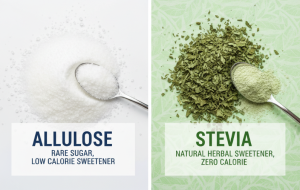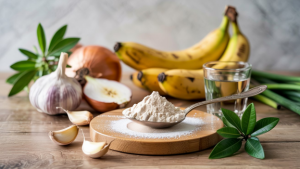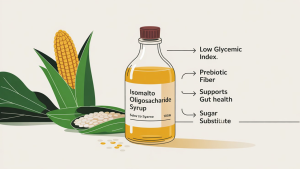Is Maltitol Syrup Gluten Free? A Comprehensive Guide

Maltitol syrup shows up everywhere—from sugar-free candies and baked treats to refreshing drinks. It’s a sugar alcohol that brings sweetness with fewer calories, making it a go-to for anyone wanting to enjoy sweet flavors without the sugar overload. Because it works so well, you’ll find it in tons of low-calorie and sugar-free goodies on store shelves today.
Many people wonder if maltitol syrup contains gluten, especially with the rise in gluten sensitivities and celiac disease. Since maltitol syrup is often used in sugar-free and low-calorie foods, it’s important to know if it fits into a gluten-free diet. Understanding the possibility of cross-contamination and the syrup’s safety for those sensitive to gluten helps make informed choices.
Is Maltitol Syrup Naturally Gluten-Free?
Good news first—maltitol syrup is naturally gluten-free. It’s made by turning starches (usually from corn or sometimes wheat) into a sugar alcohol that’s sweet but with fewer calories. A 2019 study in Food Chemistry showed that the way maltitol is made actually removes the gluten proteins that can cause trouble for people with celiac disease. So, the syrup itself shouldn’t have gluten lurking in it.

Watch Out for Cross-Contamination
Here’s where things get tricky. Even though maltitol syrup starts gluten-free, it can pick up tiny amounts of gluten during production if it’s made in factories that also handle wheat or other gluten-containing grains. The Gluten Intolerance Group points out that this cross-contamination can happen, and even tiny gluten traces—less than 20 parts per million—might still be a problem if you have celiac disease or are very sensitive.
To play it safe, look for maltitol syrup that’s got a certified gluten-free label. Groups like the Gluten-Free Certification Organization (GFCO) test products rigorously to make sure gluten levels stay super low, well within FDA rules. This certification is your best friend if you want to avoid surprises.
Why Maltitol Syrup Can Be a Smart Choice
Aside from gluten concerns, maltitol syrup has some perks. According to a 2021 review in the Journal of Nutritional Science, it has a low glycemic index—meaning it won’t spike your blood sugar like regular sugar might. That makes it a decent option if you’re managing diabetes or just want to keep your energy steady.
All in all, maltitol syrup can fit nicely into a gluten-free lifestyle—just choose certified gluten-free versions and you’re good to go. Plus, you get the bonus of a sweetener that’s easier on your blood sugar, which is always a win.
Industrial Uses of Maltose
Maltose, a disaccharide sugar composed of two glucose molecules, plays a significant role in the food and beverage industry, particularly as an intermediate in the production of maltitol syrup. It is primarily derived from starch sources such as corn or wheat through enzymatic hydrolysis.
Key Industrial Applications:
- Sweetener Precursor
Maltose serves as a crucial raw material in the manufacture of sugar alcohols like maltitol. Through hydrogenation, maltose is converted into maltitol, which is widely used as a sugar substitute in sugar-free and low-calorie products. This conversion process enhances sweetness while reducing caloric content. - Fermentation Substrate
Maltose is used in brewing and fermentation industries as a fermentable sugar. It is essential in beer brewing, where maltose derived from malted barley is fermented by yeast to produce alcohol. Its predictable fermentation profile makes it a preferred carbohydrate source. - Food Additive
In processed foods, maltose contributes to flavor development and browning reactions during baking, enhancing color and texture. It can also act as a humectant, helping retain moisture in baked goods and confectioneries. - Pharmaceutical Industry
Maltose is sometimes utilized in pharmaceutical formulations as a stabilizer and sweetener in syrups and oral medications, improving taste and stability without introducing gluten.
Procurement Tips: What Buyers Should Look For

When sourcing maltitol syrup, not all products are created equal. Here’s what savvy procurement teams usually watch out for:
| Key Factor | Why It Matters |
| Purity Level (% Maltitol Content) | Higher maltitol content often means better sweetness performance and less risk of side sugars interfering with flavor or digestion. |
| Source Material (Corn vs. Wheat) | If your end product is gluten-free, corn-based sources are often preferred—less risk of gluten trace contamination. |
| Certifications | Look for Non-GMO, Gluten-Free (GFCO), and ISO certifications to ensure safety and global compliance. |
| Viscosity & Solubility | Viscosity affects mouthfeel and processability, especially in syrups and beverages. Always match syrup grade to application. |
| Supplier Transparency | Reputable suppliers provide a complete spec sheet, CoA (Certificate of Analysis), and microbial test results. Ask for them. |
Common Formulation Applications
Maltitol syrup is impressively versatile. Here’s how R&D teams commonly incorporate it across product types:
| Product Type | Typical Use of Maltitol Syrup |
| Protein Bars / Meal Replacements | Acts as a binder, keeps texture chewy, adds sweetness without sugar spike. Often combined with soluble fiber or polydextrose. |
| Sugar-Free Confectionery | Used to replace sucrose in candies, hard gums, and lollipops—great for smooth texture and no aftertaste. |
| Functional Beverages | Adds mild sweetness without impacting blood sugar, suitable for keto or diabetic-friendly formulations. |
| Baked Goods | Withstands baking temperatures, adds moisture retention and soft crumb to cakes, muffins, and cookies. |
| Pharmaceutical Syrups | Used as a sweet-tasting base for oral medications, especially pediatric formulations due to low cariogenic risk. |
Regulatory Snapshot: Is It Export-Ready?
If you’re producing for export, maltitol syrup is generally well-accepted globally, but here are a few things to know:
- USA: Approved as a GRAS (Generally Recognized as Safe) food ingredient by the FDA. Gluten content must remain under 20 ppm to qualify for “gluten-free” labeling.
- EU: Classified under E965. EU regulations require sugar alcohols to carry a warning: “excessive consumption may cause laxative effects.”
- China: Widely accepted in health foods and beverages, especially for functional applications. Labeling must comply with GB standards.
- Middle East: Halal certification is important for regional compliance; some manufacturers offer halal-grade maltitol syrup.
Pro Tip: Many food-tech exporters now offer dual-certified (halal + gluten-free + non-GMO) grades of maltitol syrup, which helps simplify compliance across multiple markets.
Logistics & Shelf Life: Easy to Store, Easy to Scale
One reason maltitol syrup is favored by large-scale food processors is its stability and shelf life. Unlike some alternative sweeteners that are sensitive to moisture or temperature swings, maltitol syrup:
- Has excellent storage stability—typically 12 to 24 months in sealed containers under room temperature.
- Is non-crystalline, so it doesn’t solidify like some syrups, making it ideal for bulk dispensing and automated filling lines.
- Maintains viscosity consistency even after repeated exposure to mild heat (perfect for baked goods or cooking sauces).
Warehouse Advantage: Maltitol syrup is bulk-ship friendly. It’s available in drums, IBC totes, or ISO tanks, making it scalable for both regional manufacturers and multinational co-packers.
Cost Efficiency in Formulation
From a cost-performance perspective, maltitol syrup offers value beyond sweetness. For food manufacturers watching margins, it provides:
- Higher solids content than many liquid sweeteners—reducing the need for bulking agents.
- Lower usage levels than sugar in some formulations due to synergistic sweetness with other polyols.
- Reduced sugar tax exposure in countries with sugar-based levies (e.g., UK, Mexico).
Case Study Insight: A 2023 whitepaper by Euromonitor showed that confectionery brands switching from sucrose to maltitol syrup in Southeast Asia cut raw ingredient costs by up to 18%, due to decreased tariff classification under sugar-reduced categories.
Sustainability: Better Fit for “Clean Label” Shifts
More B2B buyers are now factoring sustainability and consumer sentiment into purchasing decisions. Maltitol syrup aligns well with these trends:
- Plant-based origin (corn or wheat starch) fits into plant-forward, vegan-friendly formulations.
- Non-GMO versions available, which are increasingly preferred in North America and parts of Europe.
- No artificial additives, preservatives, or synthetic solvents used in production—important for clean label claims.
- Lower carbon footprint per sweetening unit compared to cane sugar, especially when sourced locally.
Tip for Sustainability Teams: Some suppliers now provide carbon disclosure metrics for maltitol syrup batches—ask for them to boost your ESG reporting.
References and Sources
- Food Chemistry, 2019. “Effects of hydrogenation on gluten proteins in maltitol production.”
- Gluten Intolerance Group (GIG). “Gluten Cross-Contamination Risks in Food Manufacturing.”
- Celiac Disease Foundation. “Gluten Thresholds and Health Impact.”
- Gluten-Free Certification Organization (GFCO). “Certification Standards and Testing Protocols.”
- Journal of Nutritional Science, 2021. “Glycemic Index of Sugar Alcohols and Their Impact on Blood Glucose.”
- American Dietetic Association. “Sugar Alcohols and Digestive Health.”
- Brewing Science, 2020. “Role of Maltose in Alcohol Fermentation.”
- Pharmaceutical Technology, 2018. “Use of Disaccharides as Excipients in Oral Syrups.”
Related recommendations
-
Allulose vs Stevia: Which Is Your Healthier Sweetener Choice
267Compare Allulose Vs Stevia In Sweetness, Health Effects, Weight Loss, And Tooth Safety. Find Which Sweetener Suits Your Needs Best.
View details -
Fructo-Oligosaccharide Powder: Health Benefits and Uses
833Discover What Fructo-Oligosaccharide Powder Is, Its Health Benefits, And Common Uses In Food And Supplements-SGNUTRI.
View details -
Why Glucose Could Be the Ingredient Your Business Is Missing
432Nowadays, cost, stability, and consumer appeal are constant battles. The ingredients you ignore in daily life can also become your missed business opportunities. Starch sugar is not just a sweetener—it is the hidden driver behind better margins...
View details -
Isomalto Oligosaccharide Syrup: Versatile Prebiotic
814Support Digestion And Wellness With Sgnutri's Imo Syrup – Ideal For Health Foods And Functional Beverages.
View details
 SGNUTRI
SGNUTRI



